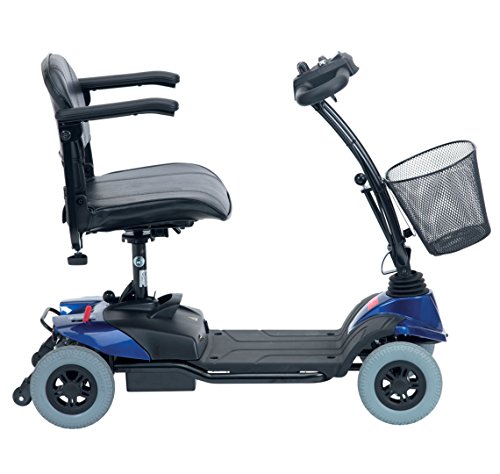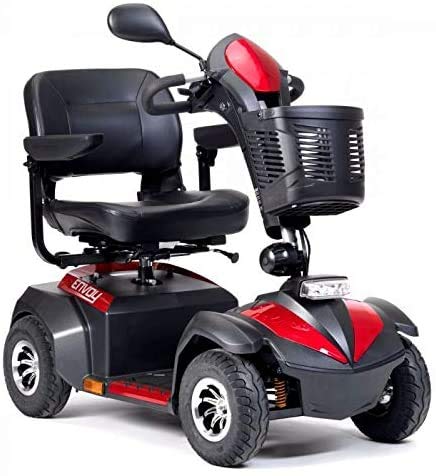Looking For Inspiration? Try Looking Up Can Mobility Scooters Go On Th…
페이지 정보
작성자 Tracy 작성일24-07-12 17:34 조회3회 댓글0건본문
 Can Mobility Scooters Go on the Pavement?
Can Mobility Scooters Go on the Pavement? Mobility scooters give you the Discover Freedom with the Portable Drive Scout Scooter to shop, meet friends or pop into your local café.
Mobility scooters give you the Discover Freedom with the Portable Drive Scout Scooter to shop, meet friends or pop into your local café.Mobility scooters in class 2 and 3 may be driven on pavements however, they cannot be driven on bus lanes or cycling-only routes.
In general, it is not advisable to drive on a scooter anywhere including dual carriageways that have speed limits of over 50mph.
Class 1
It is best to begin with a slow walk on the pavement then move on to roads when you feel more comfortable. It takes time to become comfortable with the controls, just like when driving a car. It is not necessary to have an driving license for the class 1 scooter, unlike cars. However, it's always recommended to read the Highway Code For Mobility Scooter Users.
When operating the mobility scooter, it's important to remember that pedestrians are also present in the area and have priority over other traffic. It's essential to maintain an appropriate speed and not block or obstruct traffic flow, especially in areas with a lot of traffic. Also, make sure you use the right safety gear and wear a helmet as this can significantly reduce your risk of injury.
On sidewalks, the speed limit for mobility scooters is typically Envoy 4 Lightweight Mobility Scooter with Basket speed. This allows for a safe rate of travel, without causing traffic or threatening pedestrians. Mobility scooters must also be equipped with reflectors and lighting to enhance visibility in dim lighting conditions.
A class 2 scooter can travel at speeds of up to 4mph and can be used on the roadway or on the sidewalk (if there isn't any pavement). You must abide by all traffic laws, which includes stopping at intersections to give space to pedestrians. Additionally, you must keep your distance from other pedestrians and use crosswalks to avoid collisions.
Class 3 scooters are more powerful and travel up to 8 mph. These scooters are perfect for long journeys or shopping excursions. You can use them on zebra crossings and sidewalks. However, you cannot use them on bus lanes or motorways. They should also be capable of restricting their speed to 4 mph on pavement. This is usually done using a switch.
When operating a mobility scoot the most important thing to bear in mind is to put your safety and that of others first. It's essential to always operate your scooter at an appropriate speed, avoid obstructing pedestrians, and never carry passengers on the scooter. It is also recommended to avoid drinking alcohol or taking medications that might cause drowsiness when operating the vehicle.
Class 2
Class 2 mobility scooters are limited to a maximum of 4mph. They are typically used on pedestrian and pavements. They can also be driven on roads, however it is advisable not to drive your scooter at speeds greater than this while on the road (unless you own a class 3 scooter).
If you use a Class 2 scooter, you need to be sure to not go up or down kerbs that are too high for your scooter to comfortably get over. This could cause your scooter's control to lose control or might even fall over. Check with your manufacturer if are unsure of the correct method of ascending or descending the curb. Also, you should be cautious when going downhill, especially if the ground is uneven. Be cautious when you approach a curb; if you accelerate your scooter too fast the scooter could tip over.
Be careful not to drive your scooter on paths that are only for pedestrians or cyclists. You could end up blocking their access. You should also avoid driving your scooter on dual carriageways, motorways or highways unless you've got an active flashing amber light installed.
You can use your Class 2 scooter inside buses. However, you must attend a course of instruction to learn how to safely exit and enter the vehicle. It is recommended to follow the code of conduct laid out by Confederation of Passenger Transport to avoid putting yourself or other passengers in danger.
Unlike Class 1 scooters that require a licence to operate a Class 2 model. You still need to register your scooter (V55/4 when you own newer model or V55/5 in the event that you have an older model) with the DVLA. You'll also need to buy an telescopic rear-view mirror a hazard alert switch, and lights that are compliant with the Road Vehicle Lighting Regulations. You'll also require an extra battery, and charge it regularly. Visit our showroom and test various mobility scooters to find the one that's perfect for you. We have a wide selection of mobility products on display and our friendly team can assist you in finding the perfect model.
Class 3
Mobility scooters are classified into two major categories which are class 2 and 3 scooters. Both have their own uses and advantages, however it is important to know the differences between them before deciding which scooter to purchase. Class 2 scooters are smaller and lighter than models of class 3, making them easier to transport and store. They also are more maneuverable which allows them to travel around shops and transport stations. Class 2 mobility scooters are limited to 4 mph on pavements. They are not able to drive on cycle paths or roads.
Class 3 mobility scooters have more power and can achieve speeds of up to 8 mph. They can be used on the road and are typically used for long distance travel. Like any vehicle, it is crucial to follow the rules of the road. Also, make sure your scooter is properly lit and indicators so that other road users can see the vehicle. It's also a good idea to familiarise yourself with the controls prior to going on the roads, as it can be a bit daunting to take the steering wheel of a vehicle at the speed of a car at such a high rate.
Answering this question depends on your lifestyle and preferences. In general class 3 mobility scooters are the best choice for people who require greater independence than crutches or a manual chair will provide. However, it's worth noting that if you're thinking of purchasing a class 3 scooter, you have to be able to demonstrate your ability to drive safely and responsibly prior to being accepted by the DVLA.
The most frequent question we get moving with our red mobility scooter (www.mymobilityscooters.uk) asked is "can I travel on sidewalk with a mobility scooter class 3?" The answer is yes, if you're within the speed limit of 4 speed. This is to protect yourself and other pedestrians from harm and to avoid collisions. Additionally, it is not advisable to drive your class 3 scooter on a dual carriageway unless you have an active amber flashing light.
Right of way
Mobility scooters are a fantastic tool that allows people to get around easily and with a great deal of independence. They are still motorized vehicles and should be operated in public places safely. Many people wonder whether it is safe to drive a scooter on the pavement and at what speeds they can travel at. Most states allow individuals to drive their mobility scooters on the pavement but there are a few guidelines and rules you need to be aware of.
All mobility scooters of class 2 should be restricted to 4mph while on the sidewalk and in pedestrian areas. This is to make sure that the driver is able to see pedestrians. It is also not permitted for any type of mobility scooter to be driven on paths marked 'cycle only'. This is to ensure the safety of all users and to prevent any unnecessary damage or injury.
In general it is recommended to stay clear of driving on roads with traffic. These vehicles weren't designed to travel at such speeds, and they can cause serious injury if they strike anyone or something. In addition, they are less noticeable to other drivers than cars and are more likely to be involved in an accident. If you must drive on a highway, be sure to check your local laws and follow all traffic signals and signs.
Be careful crossing driveways and roads. Always walk at the right angle and never go any higher or lower than the recommended kerb. If you can, try to cross the road using a dropped road kerb, as this will provide you with a safer route and will allow you to turn corners and junctions.
Always wear a helmet when you ride a scooter and do not use it while under the effects of alcohol or drugs. It is also recommended to wear bright clothing and reflectors to help you be more visible in dim lighting. It is also advised to avoid wearing loose fitting clothes that can get caught on the wheels of the scooter.
댓글목록
등록된 댓글이 없습니다.





